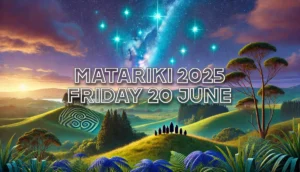The Nine Stars of Matariki
The night sky has always held a special fascination for humanity. The stars that twinkle above have guided us, inspired us, and connected us to the vast universe beyond our planet. In New Zealand, there is a celestial event that not only captivates stargazers but also carries deep cultural significance—the Māori New Year, known as Matariki. In this educational exploration, we’ll delve into the celestial wonders and cultural treasures surrounding the Nine Stars of Matariki
Key Sections :
Unveiling the Matariki Star Cluster
Matariki, often referred to as the Pleiades star cluster in Western astronomy, is a remarkable celestial formation that graces the Southern Hemisphere’s night sky. In Māori tradition, Matariki signifies the Māori New Year, a time of celebration, reflection, and renewal. This dazzling cluster consists of nine stars, each carrying its unique Māori name, Greek counterpart, gender, and associated provenance.
Nine Stars oF Matariki
| Māori | Greek | Gender | Provenance |
|---|---|---|---|
| Matariki | Alcyone | Female | Well-being and health |
| Tupu-ā-rangi | Atlas | Male | Food that comes from above |
| Tupu-ā-nuku | Pleione | Female | Food that grows in the soil |
| Ururangi | Merope | Male | The winds |
| Waipunā-ā-rangi | Electra | Female | Rainwater |
| Hiwa-i-te-rangi | Celaeno | Female | Growth and prosperity |
| Waitī | Maia | Female | Fresh water |
| Waitā | Taygeta | Male | The ocean |
| Pōhutukawa | Sterope | Female | The deceased |
Let’s embark on a celestial journey as we explore the profound meaning and cultural richness behind each of these stars.
Matariki (Alcyone)
Gender: Female
Provenance: Well-being and health
Our celestial journey begins with Matariki, the leader of the Matariki star cluster. Known as Alcyone in Greek mythology, this star embodies the essence of well-being and health. In the Māori culture, Matariki represents a fresh start and an opportunity for personal growth and rejuvenation. As we gaze upon Matariki, we are reminded of the importance of nurturing both our physical and mental health for a fulfilling life.
Tupu-ā-rangi (Atlas)
Gender: Male
Provenance: Food that comes from above
Next in our cosmic exploration is Tupu-ā-rangi, mirroring the Greek star Atlas. This star carries a male association and signifies food that descends from the heavens. It highlights the interconnectedness of celestial blessings, such as rain and sunlight, with agriculture and food production. Tupu-ā-rangi reminds us that the cosmos plays a vital role in nurturing our crops and sustaining life.
Tupu-ā-nuku (Pleione)
Gender: Female
Provenance: Food that grows in the soil
As we continue our celestial journey, we encounter Tupu-ā-nuku, akin to the Greek star Pleione. This female star represents food that originates from the Earth’s soil. It symbolizes the significance of agriculture and the fertility of the land. The nurturing and cultivation of crops from the earth connect us to the very essence of sustenance and the Earth’s abundance.
Ururangi (Merope)
Gender: Male
Provenance: The winds
Our journey takes an atmospheric turn with Ururangi, embodying the winds. Corresponding to Merope in Greek mythology, this star highlights the crucial role of wind patterns in shaping weather conditions and aiding navigation. In the maritime world, Ururangi has historically been instrumental, emphasizing the significance of this star in maritime culture.
Waipunā-ā-rangi (Electra)
Gender: Female
Provenance: Rainwater
As we look up at the starry night, we encounter Waipunā-ā-rangi, akin to Electra in Greek mythology. This female star signifies rainwater, a life-giving force that sustains ecosystems and communities. It reminds us of the importance of rain in nourishing the land, providing fresh water sources, and supporting life on Earth.
Hiwa-i-te-rangi (Celaeno)
Gender: Female
Provenance: Growth and prosperity
Our celestial journey continues with Hiwa-i-te-rangi, symbolizing growth and prosperity. This female star encourages individuals and communities to pursue their aspirations, nurture their potential, and work toward a prosperous future. It represents the optimism and hope associated with personal and collective growth during the Māori New Year.
Waitī (Maia)
Gender: Female
Provenance: Fresh water
Next, we encounter Waitī, corresponding to Maia in Greek mythology. This female star is associated with fresh water sources. It serves as a reminder of the critical importance of clean and accessible water for sustenance, health, and overall well-being. Waitī embodies the significance of preserving and cherishing this precious resource.
Waitā (Taygeta)
Gender: Male
Provenance: The ocean
As our celestial journey continues, we reach Waitā, a male star linked to the vastness of the ocean. Similar to Taygeta in Greek mythology, Waitā symbolizes the oceans’ abundance, resources, and historical significance in Māori culture. It highlights the role of marine environments in navigation and cultural practices.
Pōhutukawa (Sterope)
Gender: Female
Provenance: The deceased
Our cosmic exploration concludes with Pōhutukawa, a female star associated with the deceased and the spirits of ancestors. Pōhutukawa represents a time for remembrance and honoring those who have passed away in Māori culture. It underscores the importance of preserving cultural heritage and traditions, keeping the memories of loved ones alive.
The Cosmic Tapestry of Matariki
The “Nine Stars of Matariki” collectively form a celestial tapestry that reflects the interconnectedness of the Earth, the cosmos, and the rich heritage of the Māori people. Each star carries not only astronomical significance but also cultural and symbolic meanings deeply rooted in Māori tradition.
As we look up at the night sky and marvel at the brilliance of Matariki, we are reminded of the profound connections between the celestial and the terrestrial. The Matariki star cluster serves as a celestial calendar, marking the Māori New Year and offering an opportunity for communities to come together
The Cultural Significance of Matariki
Matariki represents more than just a celestial event; it’s a cultural tapestry that weaves together stories, traditions, and values. The Māori people celebrate this time with various activities, including cultural performances, stargazing, storytelling, and gatherings that foster a sense of community and connectedness. It’s an occasion to learn about Māori heritage, share in the rich cultural experience, and honor the spirits of the ancestors.
Matariki: A Time for All
One of the remarkable aspects of Matariki is its inclusivity. Matariki celebrations are open to everyone, regardless of cultural background. It’s a unique opportunity for individuals from diverse walks of life to come together, learn about Māori traditions, and celebrate the New Year as a community. Matariki bridges cultural gaps and fosters cultural understanding and appreciation.
How to Learn More
To delve deeper into the world of Matariki and its stars, there are several avenues to explore. Educational resources, both online and in print, offer in-depth insights into Matariki’s cultural and astronomical significance. Cultural centers and museums often host exhibitions and events related to Matariki, providing immersive experiences. Additionally, attending Matariki events, engaging with local Māori communities, and seeking out Māori experts and elders can offer valuable knowledge and a more profound understanding of this celestial celebration.
FAQs About The Nine Stars of Matariki
What is the historical and cultural significance of “The Nine Stars of Matariki”?
“The Nine Stars of Matariki” hold immense cultural significance in Māori tradition. These stars have been part of Māori heritage for centuries, serving as celestial markers for seasonal and cultural events. They are associated with a rich tapestry of stories, rituals, and teachings that have been passed down through generations.
How do the Matariki stars align with the Māori lunar calendar?
The appearance of the Matariki star cluster marks the beginning of the Māori New Year. It aligns with the lunar calendar, as Māori traditionally used the moon and stars for navigation and timekeeping. The stars’ reappearance in the pre-dawn sky signaled the start of a new agricultural year, making them essential for planning planting and harvesting seasons.
Are there variations in the names and meanings of “The Nine Stars of Matariki” across different Māori iwi (tribes)?
Yes, there can be variations in the names and meanings of these stars among different Māori iwi. While the core concepts remain consistent, regional variations in names and interpretations reflect the diverse cultural expressions and connections to the stars across Māori communities.
How do Māori communities traditionally celebrate Matariki?
Matariki celebrations can vary among different Māori communities, but they often include cultural performances, storytelling, waiata (songs), kai (food), and stargazing. These celebrations foster a sense of cultural identity, belonging, and unity.
What role does the Matariki star cluster play in Māori storytelling and mythology?
The Matariki stars feature prominently in Māori mythology and storytelling. They are often associated with ancestral figures, legends, and narratives that convey important cultural and moral lessons. These stories connect the celestial realm with the terrestrial, emphasizing the interconnectedness of all things.
How do Māori communities incorporate the themes of “The Nine Stars of Matariki” into their daily lives?
The themes represented by the Matariki stars, such as well-being, food, growth, and prosperity, are integral to Māori daily life. These concepts influence various aspects, from traditional land use and agriculture to contemporary cultural practices and well-being initiatives.
Are there specific Matariki star rituals or ceremonies that are performed during the Māori New Year?
While specific rituals can vary among Māori communities, some common elements include the raising of the Matariki flag, offering of karakia (prayers), sharing of kai, and storytelling. These rituals are intended to honor the stars and connect with cultural traditions.
How can non-Māori individuals respectfully participate in Matariki celebrations?
Non-Māori individuals can participate respectfully by attending public Matariki events, learning about Māori traditions, and following cultural protocols. It’s essential to approach these celebrations with an open mind, a willingness to learn, and respect for the cultural significance of the occasion.
Can you recommend resources for a deeper understanding of “The Nine Stars of Matariki”?
To gain a deeper understanding of “The Nine Stars of Matariki,” you can explore books, documentaries, and online resources dedicated to Matariki and Māori culture. Visiting cultural centers, attending Matariki events, and engaging with Māori experts and community leaders can provide invaluable insights.
How has modern astronomy and science contributed to our understanding of Matariki and its stars?
Modern astronomy has allowed us to better understand the celestial mechanics and properties of the Matariki star cluster. Scientific research and observation have complemented traditional knowledge, enriching our understanding of these stars’ astronomical characteristics and their cultural significance.
Nine Stars of Matariki Inspired Image

Here is an original image inspired by ‘The Nine Stars of Matariki’, incorporating Māori celestial motifs and symbols in a creative and culturally respectful manner.



hi